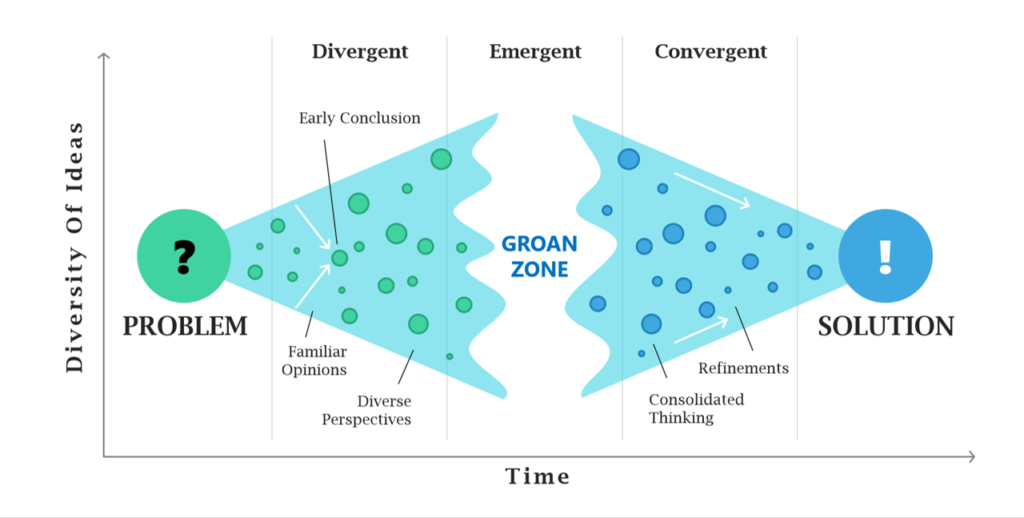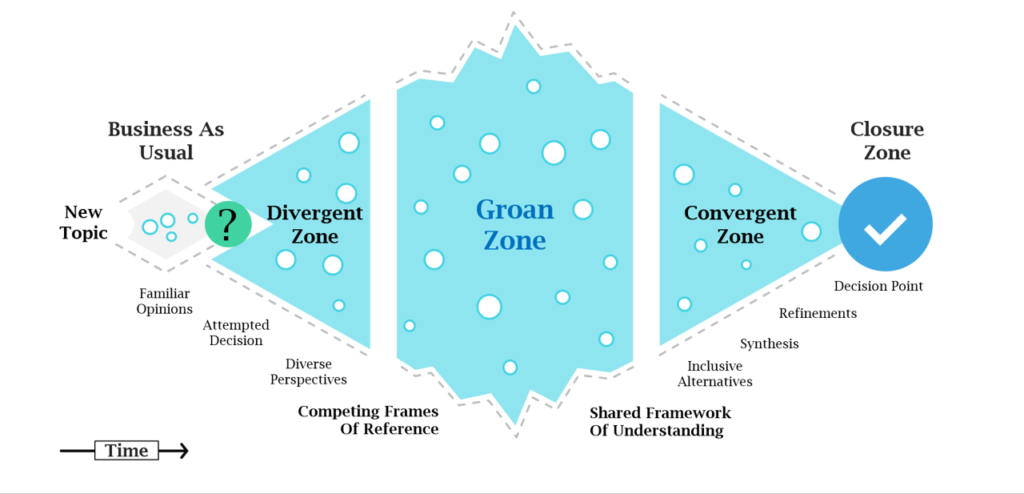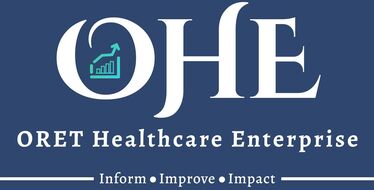Imagine you are a core team member of a community health center in an underserved community. Your organization’s mission is to ensure health equity, amplifying the voices of those with limited access to quality health care due to their socioeconomic status or geographical location. Your daily challenges include tackling complex issues that persist in your community. You work relentlessly to bridge the health equity gap, striving to equalize healthcare availability and accessibility for everyone in the community.
The ‘Groan Zone’: A Crucial Phase in Strategy Planning
As you and your team initiate strategic planning sessions to address these problems, you encounter a situation of conflicting ideas and perspectives. During strategic planning meetings, the conference room buzzes with team members arguing about different strategies and solutions. This stage in your collaborative problem-solving journey is commonly called the ‘Groan Zone.’ It is a time of ambiguity and discordant views. Though initially seeming chaotic, the diverse perspectives are an inevitable and critical phase of participatory decision-making. This phase will lead to comprehensive and innovative solutions to improve healthcare access and lower costs in your community.

Navigating Divergence: The Power of Many Ideas
Consider a strategy meeting where you brainstorm how to enhance community healthcare access. One team member, a seasoned nurse with decades of experience in community health, passionately advocates for mobile clinics. She recounts her encounters with patients living in remote areas, struggling to make it to their appointments due to unreliable transportation. She explains that these clinics’ vision could be a lifeline for such patients, ensuring regular access to necessary medical care.
On the other hand, a recently hired healthcare IT specialist sees the situation through a different lens. He proposes the implementation of telemedicine services. Armed with data and case studies, he makes a compelling argument about how telemedicine could be a more cost-effective solution. He highlights the growing digital literacy rates and availability of internet services even in these underserved communities, creating a strong case for this solution.
Then there’s the operations manager, who has been managing the finances and has her eyes on the budget. She brings an entirely different perspective to the table. She advocates for forging partnerships with governmental agencies or nonprofits to ensure sustained funding. She argues that these partnerships can provide the financial backing to implement and maintain improved healthcare services.
This divergence of ideas might seem overwhelming, even chaotic at times. However, it is crucial to understand that this chaos holds the potential for creative solutions. In this phase, the ‘Groan Zone,’ all possible solutions are put on the table, explored, and analyzed. The more ideas presented, the more likely it is to develop into an innovative and sustainable solution to complex challenges. Each perspective and idea brings us one step closer to creating a comprehensive solution that considers all aspects of the problem.
Steering Through the Groan Zone: Transforming Ideas into Actionable Strategies
Although the ‘Groan Zone’ might feel overwhelming, it is a crucial phase for solution-building. It requires skillful facilitation, an open-minded approach, and a tolerance for ambiguity. Here are a few strategies and tools to guide you through:
- Promote Open Dialogue: Encourage all members to share their thoughts without judgment. This openness can lead to a better understanding of each perspective and foster a sense of ownership within the team.
- Utilize Decision-making Tools: Tools like SWOT analysis or the Nominal Group Technique can help evaluate each proposition’s feasibility, potential impact, and alignment with your organization’s mission and the community’s needs.
- Prioritize Ideas: Create a voting system to rank the ideas based on their potential impact and feasibility. This can simplify the decision-making process and ensure that all voices are heard.
- Prototype and Test: Develop simple prototypes for the top-ranked ideas and test them in a controlled environment. This will provide real-time feedback and reduce the risk of failure.
Encouraging Emergence: Converging Ideas for Innovative Healthcare Solutions
As the team navigates the Groan Zone, they diligently evaluate each perspective, analyzing their feasibility, sustainability, and impact. Gradually, the process of ’emergence’ takes over, where your team notices the potential for synergy among the diverse ideas. The focus shifts from each individual idea to a potential combination of them. This often leads to more innovative and practical solutions encompassing different concepts’ strengths while mitigating their weaknesses.
In our scenario, a breakthrough emerges as a hybrid model of the mobile clinic and telemedicine propositions, where both ideas feed into each other to create an efficient and adaptable care delivery model. The mobile clinics provide immediate, in-person healthcare services, focusing on reaching remote locations and bringing essential services closer to underserved populations.
Simultaneously, telemedicine could offer the perfect avenue for cost-effective follow-up care, chronic disease management, and health education. This creative synergy during the ’emergence’ phase brings us closer to achieving healthcare equity.

Embracing Convergence: Uniting for a Shared Vision for Healthcare
The final phase, ‘convergence,’ signifies the end of the ‘Groan Zone’ and the emergence of a shared vision. Everyone in your team, who started with different perspectives, now aligns with a single, unified strategy. This shared vision will likely be more comprehensive, practical, and accepted by all stakeholders, making its implementation smoother.
The result is more than just a practical plan—a shared commitment to health equity, enhanced healthcare access, and cost reduction in your community. The converged strategy, owned by all stakeholders, paves the way for a lasting positive impact on the community.
Key Takeaways
- The ‘Groan Zone’ is a challenging yet necessary phase in decision-making, especially when dealing with complex issues like health equity, access, and costs in underserved communities.
- Encourage the divergence of ideas and maintain an open dialogue to ensure that all perspectives are heard.
- Use decision-making tools to analyze each idea’s feasibility and potential impact, then prioritize and test them.
- Allow the emergence of innovative solutions that combine the best aspects of multiple ideas.
- Strive for convergence, where all stakeholders align behind a unified, practical strategy.
Navigating the Groan Zone Together
Navigating the ‘Groan Zone’ can be challenging, but with strategic guidance from ORET Healthcare, it can be a catalyst for collaboration and innovative solutions. Join the ranks of healthcare organizations making a difference in their communities by partnering with ORET Healthcare, a performance and process improvement consulting and training firm. ORET specializes in aiding healthcare organizations steer through the ‘Groan Zone,’ transforming diverse ideas into a unified, effective strategy.
We will help you effectively address the challenges of health equity, access, and costs and transform them into opportunities for sustainable growth and community impact. Connect with us today, and let us guide you through your journey to improve healthcare in your community. By completing our free gap assessment today, you take the first step toward a better future for your organization and your communities. During your discovery call, we will dive into your unique challenges and opportunities and provide a roadmap for improvement.
